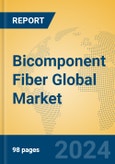Market Overview
Over the past decade, the demand for bicomponent fibers has increased significantly, driven by advancements in textile technology and a shift towards lightweight and multifunctional materials. Bicomponent fibers are specifically designed to enhance the physical characteristics of fabrics, such as strength, elasticity, and durability. They find extensive applications in hygiene products, industrial fabrics, technical textiles, and medical materials.Market Size and Growth Rate
As of 2023, the bicomponent fiber market size is estimated at approximately USD 5.6 billion, with a compound annual growth rate (CAGR) of 6.3% projected from 2024 to 2029. This growth can be attributed to the increasing demand for high-performance fabrics in the automotive, healthcare, and personal care sectors.Market Share and Trends Analysis
The market is characterized by various product types, including:- Polyester/Polyester (P/P)
- Polypropylene/Polyester (PP/P)
- Polyester/Polyamide (P/N)
- Others
Key Players in the Bicomponent Fiber Market
The market is competitive, with several key players dominating the landscape:- Huvis
- Far Eastern New Century
- Teijin
- JNC Corporation
- Indorama Ventures
- Daiwabo
- Kolon Glotech
- Jiangsu Jiangnan
- Guangzhou ES Fiber
- Toray
- Nanya Plastics
Market Segmentation
The bicomponent fiber market can be segmented based on the following criteria:By Process
- Extrusion
- Spinning
- Texturing
By Application
- Hygiene
- Fabric
- Medical
- Industrial
By End-Use
- Textile
- Healthcare
- Aerospace
- Automotive
- Construction
Regional Analysis
Regionally, the bicomponent fiber market has been segmented into:- North America
- Europe
- Asia-Pacific
- Latin America
- Middle East and Africa
North America and Europe also represent sizable markets, driven by technological advancements and a focus on innovative textile solutions, particularly in the healthcare and automotive applications.
Market News and Updates
In recent years, the bicomponent fiber market has seen several notable trends and developments:- In 2023, Indorama Ventures announced its plans to expand its production capacity for bicomponent fibers in Asia, responding to the accelerating demand in the hygiene sector.
- Teijin has invested in research to develop eco-friendly bicomponent fiber alternatives, focusing on sustainability and lowering environmental impact.
- New government policies aimed at promoting the use of non-woven materials in hygiene applications have been introduced in several countries, further boosting the market growth potential.
Segment Forecasts (2024 - 2029)
The bicomponent fiber market is expected to witness continued growth from 2024 to 2029, driven primarily by:- Increased consumer demand for eco-friendly and biodegradable fibers.
- Technological advancements in fiber production techniques, leading to better performance and lower production costs.
- Growing demand from emerging markets and sectors like healthcare and automotive, requiring high-performance materials.
Conclusion
In summary, the bicomponent fiber market is poised for significant growth driven by technological advancements, increasing consumer demands for high-performance fabrics, and the expanding application base across various industries. With major players continuously innovating and adapting to market trends, the future of the bicomponent fiber market looks promising from 2024 to 2029.This product will be delivered within 1-3 business days.
Table of Contents
Companies Mentioned
- Huvis
- Far Eastern New Century
- Teijin
- JNC Corporation
- Indorama Ventures
- Daiwabo
- Kolon Glotech
- Jiangsu Jiangnan
- Guangzhou ES Fiber
- Toray
- Nanya Plastics








